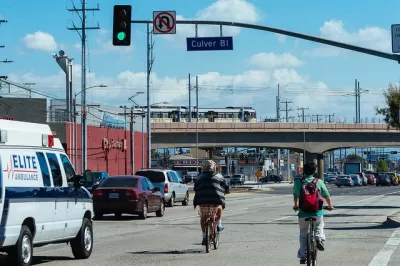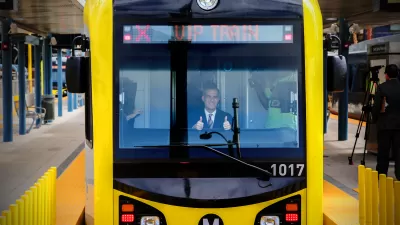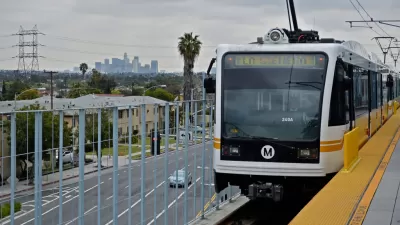Facing explosive development interest around its Metro station, the small city of Culver on L.A.’s Westside is taking steps to shape its mobility future.

Over the next four years, the five-square-mile city of Culver is expecting ten new developments focused around its Metro Expo Line station to bring 30,000 new daily trips to its streets. In anticipation of those impacts, the Los Angeles-area city has elected to craft, not just a congestion management plan, but a comprehensive vision for mobility and growth that will eventually fold into a general plan update. In The Planning Report, Culver City Vice Mayor Thomas Small and consultant Craig Nelson unpack the Transit Oriented Development Visioning Plan.
Small explains:
Our solution in Culver City is not to try to stop development, but to work with it, and to create a multimodal mobility system that will enable all these people to get around. We need a mobility system that will work with development.
Culver is just one small piece of a patchwork of more than 30 transit networks in Los Angeles County. To create a "complete journey" for riders, the plan will have to find a way to make the transition between infrastructure systems feel seamless.
Creating an easy, comfortable experience is a core component of the plan, which relies heavily on detailed community outreach. That's important in part because transit ridership is falling throughout L.A. County as well as nationwide. Nelson explains:
I’m striving to help transit agencies in the US think beyond a new app, a new website, or new sensors across the network. You need to speak to your users. You need to understand why they don’t use the bus—why it’s uncomfortable for them to use the bus—and think about how good design, good strategy, and good policy can be used to deliver a more accessible and better-to-use transit network.
FULL STORY: Culver City Hosts Mobility Visioning Process Involving Stakeholders, Architects & Planners

Planetizen Federal Action Tracker
A weekly monitor of how Trump’s orders and actions are impacting planners and planning in America.

Canada vs. Kamala: Whose Liberal Housing Platform Comes Out on Top?
As Canada votes for a new Prime Minister, what can America learn from the leading liberal candidate of its neighbor to the north?

The Five Most-Changed American Cities
A ranking of population change, home values, and jobs highlights the nation’s most dynamic and most stagnant regions.

Op-Ed: Why an Effective Passenger Rail Network Needs Government Involvement
An outdated rail network that privileges freight won’t be fixed by privatizing Amtrak.

‘Quality Work, Fast’: NC Gears up for Homebuilding After Helene, Trying to Avoid Past Pitfalls
The state will field bids to demolish, repair and rebuild homes in the mountains. After struggles in eastern NC, officials aim to chart a different course.

Washington State’s Parking Reform Law Could Unlock ‘Countless’ Acres for New Housing
A law that limits how much parking cities can require for residential amd commercial developments could lead to a construction boom.
Urban Design for Planners 1: Software Tools
This six-course series explores essential urban design concepts using open source software and equips planners with the tools they need to participate fully in the urban design process.
Planning for Universal Design
Learn the tools for implementing Universal Design in planning regulations.
Central Transportation Planning Staff/Boston Region MPO
Heyer Gruel & Associates PA
Institute for Housing and Urban Development Studies (IHS)
City of Grandview
Harvard GSD Executive Education
Regional Transportation Commission of Southern Nevada
Toledo-Lucas County Plan Commissions




























